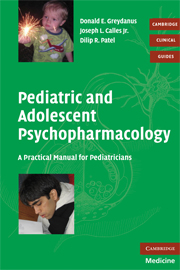Book contents
- Frontmatter
- Contents
- Contributors
- Foreword by Christopher K. Varley
- Foreword by Renée R. Jenkins
- Preface
- Acknowledgement
- 1 Principles of psychological management
- 2 The basics of pharmacology and neurotransmission
- 3 Basics of prescribing psychopharmacologic agents
- 4 Anxiety disorders
- 5 Attention deficit/hyperactivity disorder
- 6 Child and adolescent depression
- 7 Disruptive behavior and aggressive disorders
- 8 Schizophrenia in childhood and adolescence
- 9 Autism spectrum disorders
- 10 Psychotropic management of children and adolescents with cognitive–adaptive disabilities
- 11 Sleep disorders in children and adolescents
- 12 Tic disorders in children and adolescents
- 13 Substance abuse disorders
- Subject index
- References
9 - Autism spectrum disorders
Published online by Cambridge University Press: 18 December 2009
- Frontmatter
- Contents
- Contributors
- Foreword by Christopher K. Varley
- Foreword by Renée R. Jenkins
- Preface
- Acknowledgement
- 1 Principles of psychological management
- 2 The basics of pharmacology and neurotransmission
- 3 Basics of prescribing psychopharmacologic agents
- 4 Anxiety disorders
- 5 Attention deficit/hyperactivity disorder
- 6 Child and adolescent depression
- 7 Disruptive behavior and aggressive disorders
- 8 Schizophrenia in childhood and adolescence
- 9 Autism spectrum disorders
- 10 Psychotropic management of children and adolescents with cognitive–adaptive disabilities
- 11 Sleep disorders in children and adolescents
- 12 Tic disorders in children and adolescents
- 13 Substance abuse disorders
- Subject index
- References
Summary
Definition
Autism spectrum disorders (ASD) are characterized by deficits in social interaction, verbal and nonverbal communication and repetitive, stereotypical behaviors and interests. These impairments are severe, pervasive and deviant relative to the child's developmental level and mental age. Each child will display a wide range of individual variability in the behavioral symptoms. Most children manifest the early symptoms and are diagnosed between ages 18 months and 36 months; in many, diagnosis can be suspected as early as 10–12 months of age and in most by 24 months. Autism should be suspected when an infant does not babble, point, or make meaningful gestures by 1 year of age; does not speak one word by 16 months; does not combine two words by 2 years of age; does not respond to name; and loses language or social skills. Autistic disorder is classified as one of the pervasive developmental disorders according to the DSM–IV–TR; the others are Rett's disorder, childhood disintegrative disorder, Asperger's disorder, and pervasive developmental disorder not otherwise specified.
Epidemiology
Over the past several years there has been an increase in reported prevalence of ASD, and it is currently estimated to range from 2–6 per 1000 children. The reasons for the increase in the incidence of reported cases of autism are not clear and it is generally recognized that a combination of factors including increased awareness, broader definition, improved diagnosis, or a true increase in autism have been implicated.
- Type
- Chapter
- Information
- Pediatric and Adolescent PsychopharmacologyA Practical Manual for Pediatricians, pp. 155 - 162Publisher: Cambridge University PressPrint publication year: 2008

